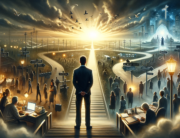. . . in a New Language
A new language emerges out of the ashes of modernism. It is decidedly the language of metaphor, and it will definitely ride a wave of emotion.
This new language will involve all forms of communication in a sensory, emotional multimedia more real than reality itself. Like all arts, rituals, and symbols, this new metaphor–this new interplay of the senses–will represent something “not there” . . . something beyond itself . . . something unseen. And it will embody the power–through God’s grace –to transform us . . . to recreate us . . . even to heal us.
Already, terms like “virtual” reality, “cyber” space, “real” time, “artificial” life, and “endo-” or “nano-” technologies blend the scientific with the sensuous, technology with touch, and the Internet with intimacy. In short, we are becoming “cyborgs”–blending cyb(ernetics) with our org(anism).
. . . in a New Art
This 21st century language will begin as a highly-developed multimedia, like the computer enhanced movies and video games of today. But it will morph quickly into a “virtual reality” far different from the traditional arts. In the hands of the church, we will call it “prophetic metaphor.”
This new language–the future form of art–will revolutionize our senses. Its science will make our emotions and feelings–especially touch–cognitive extensions of our minds.(1) In other words, we will “know” through our feelings. And, as in flight simulators, we will see no difference between “virtual” and “real” experiences.
“Felt meaning” will take on new meaning.
Twenty-first century art, for example, will cease separating the different art forms . . . it will ignore the distinction between “high” and “low” art . . . and it will refuse the myopia of turned-in cultures. Instead, it will totally wed itself to technology–even “virtual” artists will someday seek their fame.(2) And today’s performers who manipulate their audiences will be replaced by audiences who manipulate their performers.
The performing arts will change even more. As thoughts lose their logical sequence, performances will toss out their “timeline.” Music, for example, will hold a whole gamut of moods in each moment, much the way paintings present complete pictures in each glance.
The performing arts, in other words, will function more in “real time” and less on a “timeline.” Or, we can say they will become more “vertical” and less “horizontal.” Already, New Age music prefers repeated patterns to timelined “developments.”
And we see these future trends in all the arts. Derrick De Kerckhove rightly recognizes John Sanborn’s videos, Karl Sims’ computer graphics, Dieter Jung’s holography, and Monica Fleishmann’s virtual realities. Of course, we won’t computerize everything. Yet everything we do–whether online or offline–will be informed by the reality of these new feelings. And that reality requires an inner mix of art, emotion, and communication. Today’s artistic events, for example, limit themselves to particular times and places, but the art of the future will happen anyway, anywhere, anytime, and in any form . . . continuously. No longer will the preacher say, “After the music, we will have the Word.” If preaching doesn’t change, we’ll say, “Before the sermon, we will have the Word.”
. . . in a New Metaphor
As we said earlier, these new emotions are not just old feelings warmed over . . . they are not mere emotions in postmodern dress . . . they are not strictly pie-in-the-sky passions. Instead, they are empowered passions that will forever change the world.
Consider this: Virtual reality is the language of the future . . . prophetic metaphor is the power within virtual reality . . . and emotion is the power within metaphor.
Emotion is the key to the future!
Why do metaphor a nd emotion create such powerful synergies? Because metaphors, Carl Hausman writes, involve a “spiritual level.” And–at that level–they become “active forces in the world” . . . they have the power to bring “something into being.”(3) Paul Ricoeur agrees: Metaphors ground us “within a Christian vista of promise and hope,” and they have “the power not only to generate meaning but ultimately to change the world.”(4) Why not? Murray Krieger claims . . . they invoke “the miraculous.”(5) We find the same synergistic power in art, for “Metaphor is a perfect model of art.”(6) In fact, metaphor and art are the same. No wonder the sensory beauty in art “does things.”
Hans Urs von Balthasar wrote, “Overwhelming beauty points beyond itself.” Further, Carl Jung knew an art that “evokes a superhuman world.” For what purpose? “The final task of perfect art,” Vladimir Solovyov insisted, is to “transfigure our actual life.” More to the point, echoed Dostoevsky, “Beauty will save the world.” Yet, not beauty itself. . . . We “feel” the truth in beauty. So beauty, according to Sergius Bulgakov, becomes–in reality–“the reality of truth felt.” And this “felt truth” changes the world. “The artists of our era,” William Irwin Thompson writes, “are not so much describing the world as creating a new one.” “It is an expression of knowing . . . yet unborn.”
“The metaphor is probably the most fertile power possessed by man.” JosÈ Ortega y Gasset
. . . in a New Creativity
By now, we understand that creativity and emotion are also o ne . . . that intuitive visions and inspired feelings deeply require each other . . . that the excitement of discovery and the curiosity of creativity commingle. Amy Lowell was right, “Whatever (creativity) is, emotion, apprehended or hidden, is a part of it.” For “Only emotion can rouse the subconscious into action.”
The very origin of the word “emotion” means a “movement out.” When fervent hopes look forward to the fruit of inner fires . . . when hearts ignite visions of unseen things soon to be made real . . . we anticipate the “yet-to-be.” Wordsworth admitted that a creative person is simply one affected more than others “by absent things as if they were present.”
Then–oftentimes–something happens. What we envision becomes real . . . our inspiration becomes a self-fulfilling prophecy. It derives its meaning from the evidence we proclaim, even as we proclaim it. It creates a new reality from the new world we announce, even as we announce it.
As we promised at the beginning of this book, the creative future and our prophetic passions will walk hand in hand. Because power incarnates power.
“A vividly shared imagination is not simply a shared consensual delusion, but a collective form of incarnation; it is more like a civilization than a fantasy.”(7) William Irwin Thompson
. . . in a New Reality
Finally, a new science –quantum physics–now turns old science upside-down and affirms what artists have always known. Today, we often speak of quantum leaps–sudden and significant changes–never fully understanding these are “leaps” between parallel worlds of unpredictable powers.(8) Why does this new science concern empowered passions? Because in quantum worlds . . . more matters than matter!
“What else but quantum mechanics,” ask the thinkers, “explains the miraculous event of creativity.”(9) “Since imagination locates itself in time, it must also locate somewhere in space. Somewhere, in other words, it takes on a physical reality.”(10)
And here’s how:
In the odd world of quantum, things exist in a multitude of states until tipped toward a definite outcome by the act of “measurement.” In other words, once we look, we change what is seen.
That’s the reason the imagination–or the creative images–of scientists often foreshadow their physical findings.(11) (12)
So what we imagine, then, happens in parallel worlds. There is an unavoidable bond between the observer and the world observed–between our imagination and the created image–which makes observing a quantum event without changing it impossible.(13)
We create it, and it, in turn, creates us.
Can we imagine a world made of prophetic metaphors?
We must!
An Ancient Truth
None of this is new. Again, we are not discovering a new truth, we are rediscovering a forgotten truth. It is not new wisdom, it is neglected wisdom.
Spiritual emotion has always been about power. Throughout Scripture, for example, feeling and power intimately require each other. As a result, no book has changed the world more than the Bible. Jonathan Edwards echoed this bond between might and emotion: “He who has not religious affection . . . is wholly destitute of the powerful quickening influences of the Spirit of God.”
Amazingly, the language of the postmodern future returns us to the oral tradition of the ancient Hebrews. Unlike o ur modern words–known only by the brain–Hebrew “words” emerged first from the body . . . from visceral feelings . . . from the intuitive heart . . . rather than the logical mind. To them, the “Word” was a living, aesthetic experience. That’s the reason they even talked of “dancing” with it.
No wonder, for God’s aesthetic beauty and His power are one. And His “beauty and
delightfulness” bring power to “the work of our hands.”(14) The majority of the prophetic books in the Bible, for example, are lyric oracles or poetic songs. In fact, artistic skills were a prophetic necessity. When Jehoshaphat asked Elisha to prophesy, he said, “First bring me a musician.”(15) When David appointed prophets, he demanded musicians (288 of them!).(16)
In the same way, the prophetic metaphor of the postmodern future mirrors exactly the prophetic metaphor of the ancient past. Inspired prophets were creators of comparison and contrast . . . artists of analogy and affinity . . . virtuosos of similarity and similitude. In short, they spoke the language of prophetic metaphor.
The greatest metaphor of all time, for example, was Jesus. Prophetic metaphor confirmed His entire ministry. Paul said, “(Jesus) is the exact likeness of the unseen God [the visible representation of the invisible].”(17) And finally, His very death and resurrection, Paul said, were metaphors of our own death and life in this lifetime.(18)
“With Signs Following”
The rapid innovations of the future will also recapture the miraculous creativity of the
Hebrews–their potent mixture of power and passion. Contrary to modern opinion, creativity pervades the entire Bible. The Bible’s “religious language does not describe what is,” claims Harvard’s Harvey Cox. Instead, “it describes what is coming to be.”
Jesus even built His church on creativity or “inspired vision.” A careful reading of the original
Greek in Matthew 16:15-18 reveals Jesus founded His church on spiritual revelation.
It’s not an overstatement to declare the oneness of faith and creativity. Faith anticipates the “yet-to-be.” It looks “to things that are unseen” and “perceives” the things for which we hope.
Then it gives “substance” to its vision.(19) In other words, the Hebrews constantly claimed the “coming to be.” Their foreseen future of faith and their imagined vision of creativity were the same spiritual force.
In short, they were created to create!
Quantum physics would not have surprised them either. They knew all things exist in the invisible realm before they appear in the visible realm. So their faith became the “substance”– or raw material–of which things were made.(20) They simply copied the example of God who spoke “of nonexistent things . . . as if they [already] existed” . . . “declaring the end and the result from the beginning.”(21)
They fully expected their “words” . . . their inspired visions . . . their anointed creativity . . . to go forth and do things. And their faith was confirmed “with signs following.”
So we find no surprise that under dry skies, Elijah announces, “There is the sound of abundance of rain.” Nor is it rare when Jesus declares, “I have overcome the world,” when–in reality–His victory became fact when He later died and rose again.
The rediscovery of these ancient truths brings incredible revelations. If we understand the ancient role of emotion in language, art, metaphor, creativity, and reality, we finally understand God’s intention for the arts . . . the awesome presence of worship . . . the language of the postmodern world . . . and our only hope for the future.
No longer can we dismiss feelings as “just feelings.” Let us reclaim the power of our passion.
“Fan the gift into flame.” II Timothy 1:6
(This article comes from a published book, I Felt God…I Think: Authentic Passions in the 21st
Century by Thomas Hohstadt, www.futurechurch.net)
ENDNOTES
1. Christopher Dewdney in Derrick de Kerckhove, The Skin of Culture (Toronto: Somerville House Publishing, 1995) p. xxi.
2. Ray Kurzweil, The Age of Spiritual Machines: When Computers Exceed Human Intelligence (New York: Viking, 1999) p. 279.
3. Carl Hausman, pp. 5, 111, 198.
4. Morny Joy, “Images: Images and Imagination,” The Encyclopedia of Religion, 1987 ed., VII, l08.
5. Hausman, p. 5.
6. Hausman, p. 231.
7 . William Irwin Thompson, Coming Into Being (New York: St. Martin’s Press, 1996) p. 153.
8. Kimberly A. McCarthy, “Indeterminacy and Consciousness in the Creative Process: What Quantum Physics Has to Offer,” Creativity Research Journal Volume 6 (3) 201-219 (1993).
9. John McCrone, “Quantum states of mind,” New Scientist, August 20, 1994, pp. 35, 36.
10. Michael Lockwood, Mind, Brain and the Quantum, reviewed by Stuart Sutherland in Nature, Vol 343 Feb. 1, 1990, p. 424.
11. Roger Penrose: “Shadows of the Mind: A Search for the Missing Science of Consciousness,” quoted in The New York Times, Monday, October 31, 1994, by Christopher Lehmann-Haupt [Section C, Page 20, Column 3].
12. McCrone, pp. 35, 36.
13. McCarthy.
14. Biblical “glory,” for example, means both power and beauty. See also Psalm 32:7, 118:14, 90:17; AMP.
15. II Kings 3:11-16, AMP.
16. I Chronicles 25:1, 7; II Chronicles 29:30.
17. Col 1:15, AMP.
18. Romans 6:5, AMP.
19. Hebrews 11:1.
20. Hebrews 11:1, KJ.
21. Romans 4:17, Isaiah 46:10; AMP





Add Comment